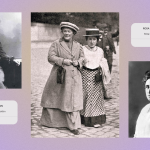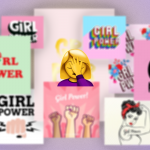
Why we celebrate March 8th
Origins and history of the International Women’s Day
March 8th, 2021
On the 8th of March of three years ago, the British House of Commons dedicated the afternoon to the discussion of International Women’s Day (in Italian International Women’s Rights Day). Several MPs have given speeches on the matter, including Stella Creasy of the Labor Party co-op. On the occasion, Creasy said that International Women's Day is considered a kind of "feminist Christmas", but that she, perhaps, felt like the Grinch of this kind of Christmas.

The first wave of feminism followed a motto: deeds not words. And this should somehow be the meaning of this day. Instead, in recent years there has been a multiplication of claims by the feminist cause without really fully supporting it. A succession of marches, beautiful photographic projects and hashtags combined with advertising campaigns full of the worst stereotypes: women who are necessarily mothers, discounted products but only from the beauty industry, posts with pink graphics, and badly trimmed mimosas. In 2018 Creasy said that "we are not making the progress we think we are and the progress is agonisingly slow", in fact at the time women represented only 30% of the deputies of Parliament - to get an idea, today in Italy women in the Senate are not even 35%. And are there non-white women? No. These data should have already portended a Grinch air for a day when there is nothing to celebrate.
The history of IWD
International Women’s Day was officially recognized in 1977 by the United Nations, but it already had its own history begun in the early twentieth century thanks to the workers' movements in Europe and North America. We can recall the speeches and resolutions made by famous Marxist feminists, such as Rosa Luxemburg and Clara Zetkin, who called for universal female suffrage. These were the years of the International Socialist Congresses (famous, in this regard, that of Stuttgart in 1907 and Copenhagen in 1910), but also of the tensions between socialists and bourgeois. Thousands of women protested and marched for their working conditions in New York as well as in Copenhagen, demanding that their rights be recognized. The difficulties caused by the First World War and the revolts in Russia helped to solidify the networks between women on a political and social level.

In all major European countries, the last week of February and the first of March began to represent a moment of reflection on the rights and political and socio-economic achievements of women, as well as on the violence and discrimination suffered. On March 8, 1917, Russian women took to the streets and, four days later, the provisional government granted them the right to vote, paving the way for British suffragettes and inspiring the 1921 decision to institute International Working Women's Day in Moscow.

After the Second World War, March 8 became a day "celebrated" in several states, losing and confusing the historical events that led to its establishment. As Marx would have said, "a spectre is haunting Europe": the spectre of the burning factory. If over the years you have heard of tragic fires and dead workers in factories as the origin of the recurrence, it's simply fake news. Each story is full of contradictions and depending on the Country in which this tradition has established itself, the date, place, and number of victims change. In the book March 8 - A century-long history, feminist Tilde Capomazza and Marisa Ombra recounted the historical origins, saying that they were probably too tied to a specific political moment (as well as pro-Russian) and that for this reason they were replaced with symbolic events of media culture.
Why the mimosa?
In Italy the 8th of March has been associated with the sprigs of mimosa (or silver/blue wattle) for an intuition of the communist parliamentarian Teresa Mattei, also the national leader of the UDI (Union of Italian Women), which also included feminists and parliamentarians Teresa Noce and Rita Montagnana. It was 1946. The choice of mimosa was quite simple and immediate: it bloomed in those weeks, even spontaneously, and it was a flower accessible to everyone from an economic point of view. It was a symbol that could be defined as poor, they put the twigs in each other's hair and took to the streets. No one in those years would have expected to see them in cellophane, in advertisements, or in Facebook posts saying that "our celebration is every day".
The society and the country with it were different, yes, but March 8 was also different. There weren't wishes to be made or chocolates and pink bows to be bought. By way of example, it would be enough to recall the manifestation of the Italian feminist movement held on March 8, 1972, in Rome, in the only historic Roman square without a church - Campo de' Fiori, where Giordano Bruno was burned alive in 1600. Date and place were not chosen at random, on the contrary, they had a very strong symbolic and political meaning. Curiosity: there was also Jane Fonda.

Today, however, this day has undergone strong commercialization and vulgarization, and it doesn't even occur to us that in the Seventies women in the square were repressed with batons, because in the meantime this week the tampons at Coop cost less.
What kind of woman?
We could talk about many other historical problems, but there are also just as many of a cultural nature. The first of all, as always, concerns representation. We have said that March 8 is International Women's Day. But what kind of woman are we referring to? Third-wave feminism has made room for feminisms, in the plural, because every woman (and every person) in the world must be contextualized geographically and politically. The history of women's day was born with white women, with a white and western-centred feminism (that considers the events of the Western world as a centre of interests and of world history). And so, as we share "girl power" posts on Instagram, how many more stories are we missing out on? The media mainly spreads mainstream feminism, providing a partial view of the current situation.

There are white women who, rightly, speak of female entrepreneurship’s problems, but who take away space - for example - from Palestinian women who still fight against honour killings and abuses of the Israeli army, or from trans women who are incessantly subjected to violence and discrimination. On this day it would be essential to focus on an overall look, to adjust the right representation in the first place in the movement, to demand a global equal recognition that is aware of the existing differences, but also of the rights that belong to all.

































































